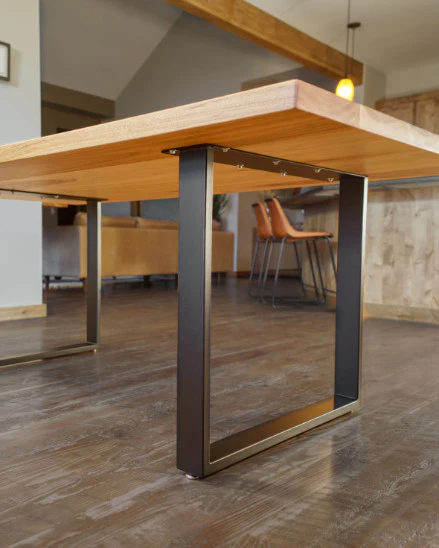An In-depth Check Out Dining Table Leg Styles: Locating the Suitable Match
Picking the appropriate eating table leg style is vital for both visual appeal and sensible functionality. For those with larger tables, trestle legs make sure sturdy support, whereas hairpin legs present a mid-century contemporary vibe with their minimalist layout. The x-shaped legs mix modern style with improved security.
Conventional Four Legs
Amongst the different kinds of dining table leg styles, the standard four-leg layout continues to be an ageless choice for lots of families. Four legs supply balanced support, making certain the table stays secure and capable of birthing considerable weight (dining room table legs).
From an aesthetic perspective, the standard four-leg design can be quickly adapted to numerous interior designs. Whether crafted from wood, steel, or a combination of materials, these legs can be delicately carved, smooth and minimalistic, or anything in between. Their versatility allows them to enhance both rustic and contemporary settings flawlessly.
Furthermore, the simple framework of the four-leg layout facilitates simplicity of movement and placement within a space. Unlike even more complex bases, this design lessens blockages, offering sufficient legroom for restaurants. In summary, the standard four-leg table leg style marries withstanding elegance with functional functionality, making it an astute selection for those seeking both form and feature in their dining furniture.
Pedestal Base
Often commemorated for its elegant and space-efficient style, the stand base is a recognized alternative to the conventional four-leg configuration in table leg designs. This distinct base generally includes a single main column sustaining the table top, which can differ in type, from ornately carved wood to sleek, modern metal. One of the primary advantages of the stand base is its capacity to make the most of legroom and seating flexibility. Without corner legs, restaurants are paid for greater freedom of motion, making it an optimal selection for round and oblong tables that advertise more intimate and comprehensive celebrations.
In addition, the pedestal base's main support can deal with substantial weight, allowing for making use of heavier table tops, such as marble or thick wood. This toughness paired with its aesthetic adaptability makes the pedestal base a prominent selection in both conventional and modern indoor setups. It can effortlessly integrate with various layout motifs, from classic sophistication to minimalist modernity. The central column itself supplies a canvas for elaborate designs and imaginative expressions, including an aspect of aesthetic rate of interest underneath the table. In recap, the stand base incorporates performance with style, making it a fine-tuned and practical alternative for diverse eating environments.
Trestle Legs
Trestle legs give a durable and classic foundation for dining tables, identified by their horizontal cross-bracing and durable assistance beam of lights. Stemming from medieval times, this layout has actually advanced yet preserved its crucial structure, making it a seasonal fave in both conventional and contemporary setups. The central trestle beam, commonly supported by 2 or more vertical posts, uses remarkable stability, permitting bigger table sizes without the requirement for extra legs.
A considerable advantage of trestle leg tables is the sufficient legroom they supply. Unlike tables with four corner legs, the absence of blockages at the table's sides gives unobstructed room for chairs and diners, enhancing convenience and ease of access. This makes trestle tables you could try here perfect for accommodating larger celebrations, whether in an eating room or a banquet hall.
From rustic farmhouse to sleek contemporary layouts, trestle legs can be personalized to fit private tastes. Their enduring charm and functional advantages make trestle legs a compelling option for those looking for both design and practicality in their eating table.
Barrette Legs

The appeal of barrette legs depends on their simpleness and versatility - dining room table legs. Available in a variety of products, consisting of steel and brass, they can be ended up in various colors to complement various indoor styles. Whether paired with a rustic wooden table top or a contemporary glass surface area, hairpin legs easily mix performance with a touch of classic charm
Resilience is an additional notable attribute of resource barrette legs. Regardless of their fragile look, these legs are crafted to birth considerable weight, making certain the table stays stable and safe. Furthermore, they are fairly very easy to install, making them a preferred selection for do it yourself lovers and professional furniture makers alike.
X-Shaped Legs

Constructed from materials such as steel, timber, or a combination of both, X-shaped legs can be tailored to match various layout choices. Steel legs usually provide a sleek and commercial feel, suitable for loft-style apartments and modern dining spaces.
In addition, the engineering behind X-shaped legs makes certain even weight distribution, minimizing the danger of tottering and boosting toughness. This makes them especially appropriate for larger table that need added support. Essentially, X-shaped legs blend practical engineering with modern-day aesthetics, making them a timeless option for varied dining environments.
Verdict
A detailed understanding of eating table leg designs reveals the distinctive characteristics and benefits of each layout. Standard four legs provide stability and classic appeal, while stand bases give legroom and a streamlined appearance. Trestle legs ensure durable assistance for larger tables, and barrette legs introduce a mid-century contemporary aesthetic. X-shaped legs integrate modern layout with improved security. Selecting the suitable leg design makes sure both practical and visual contentment in any kind of dining space.